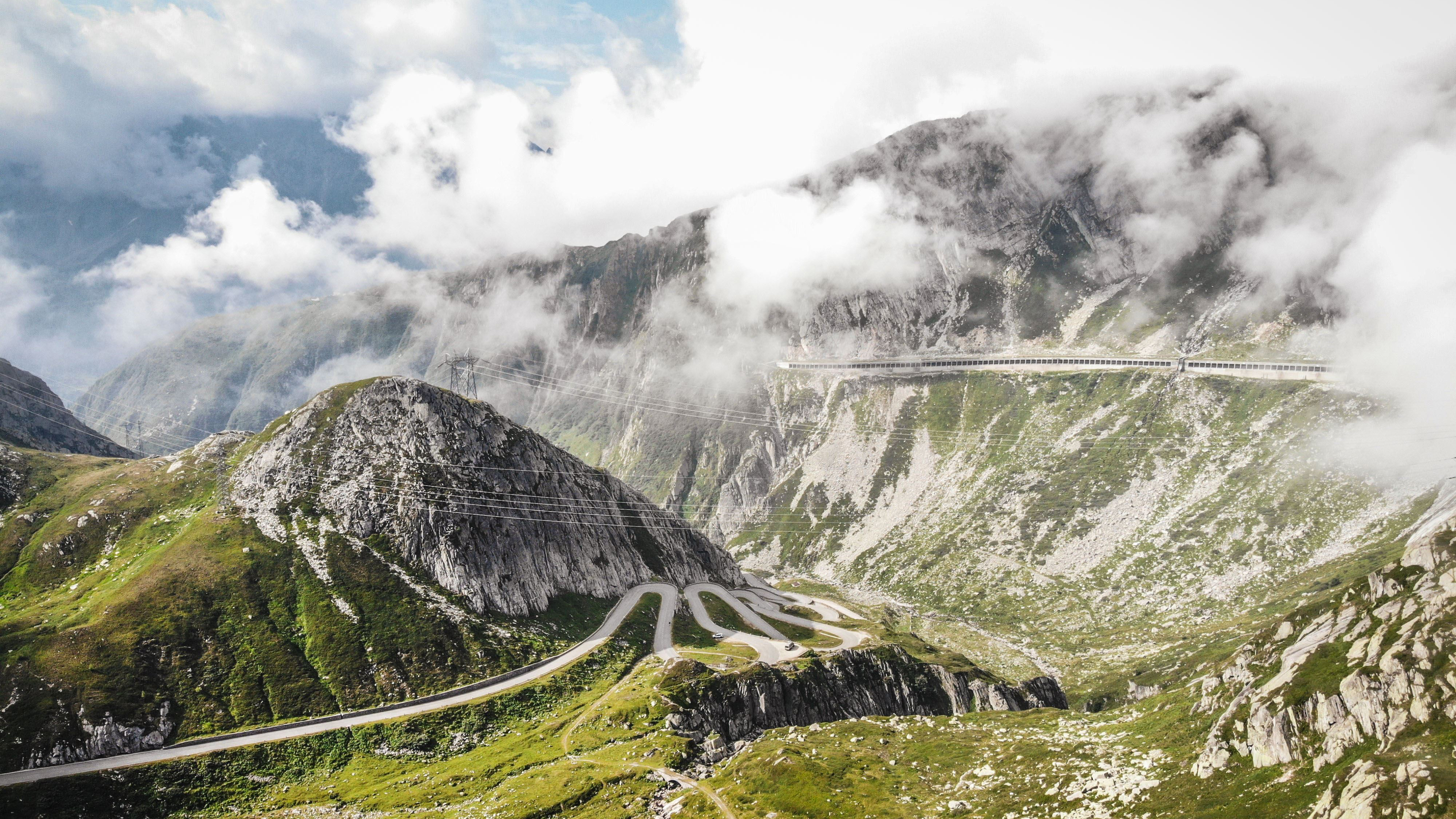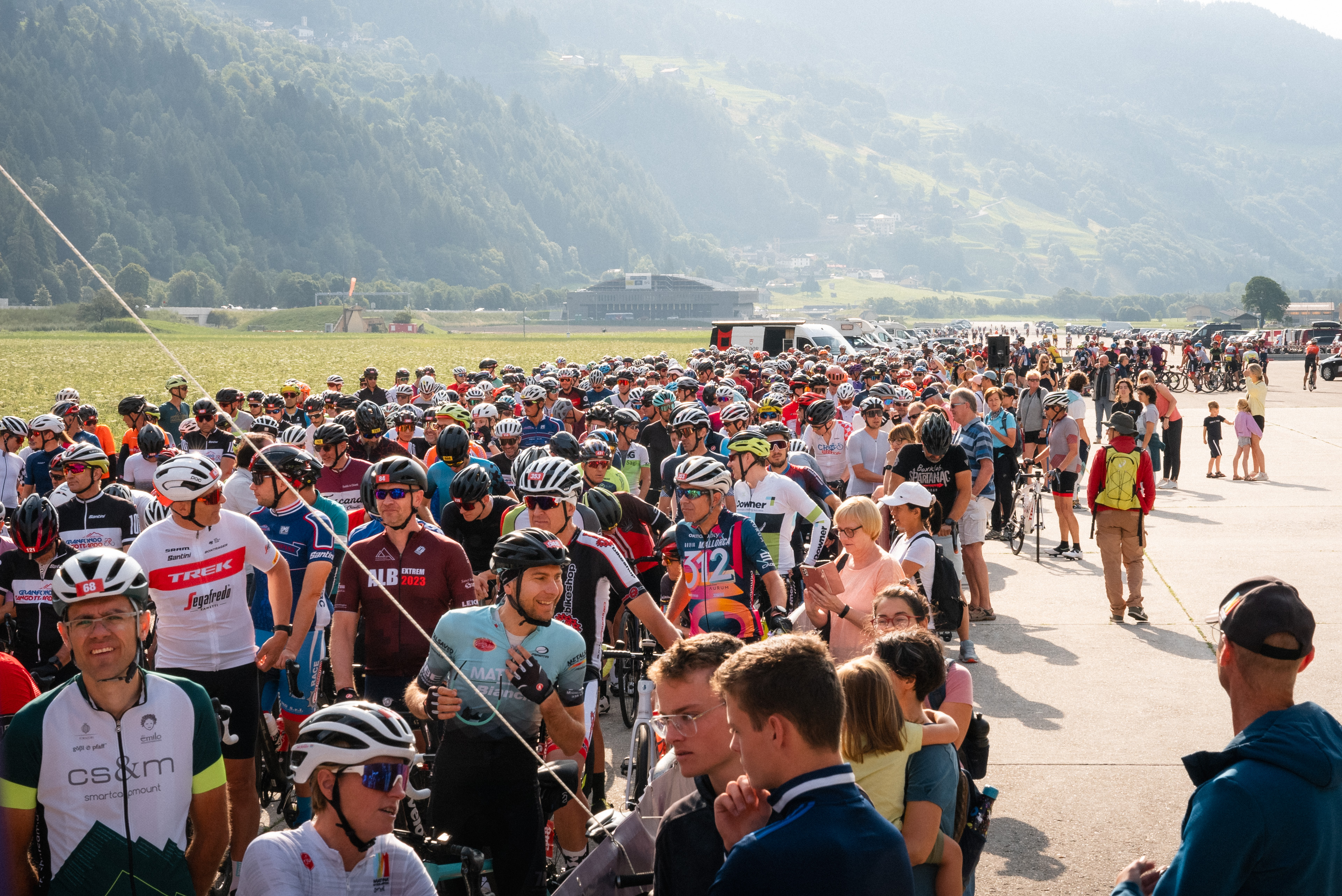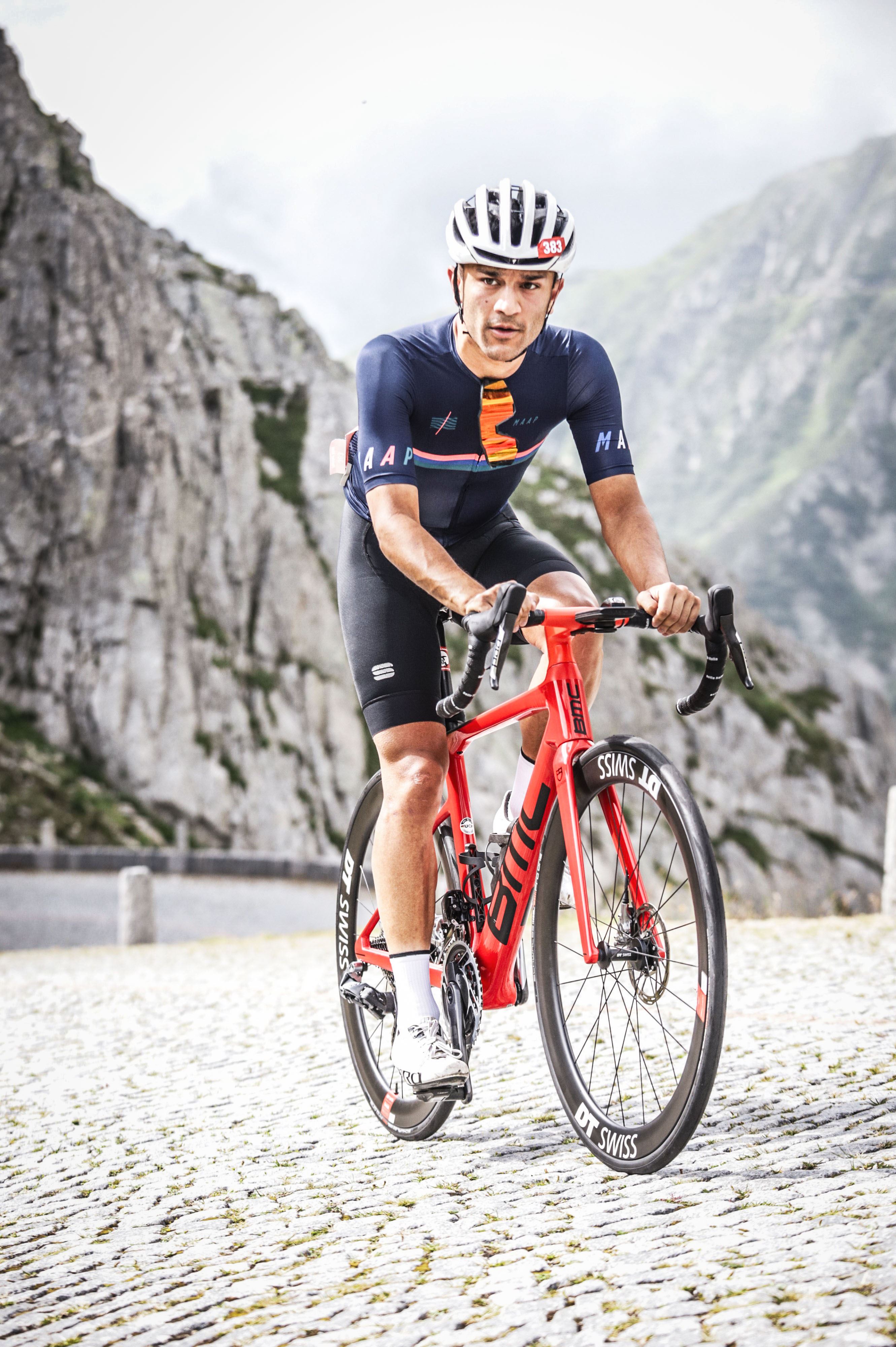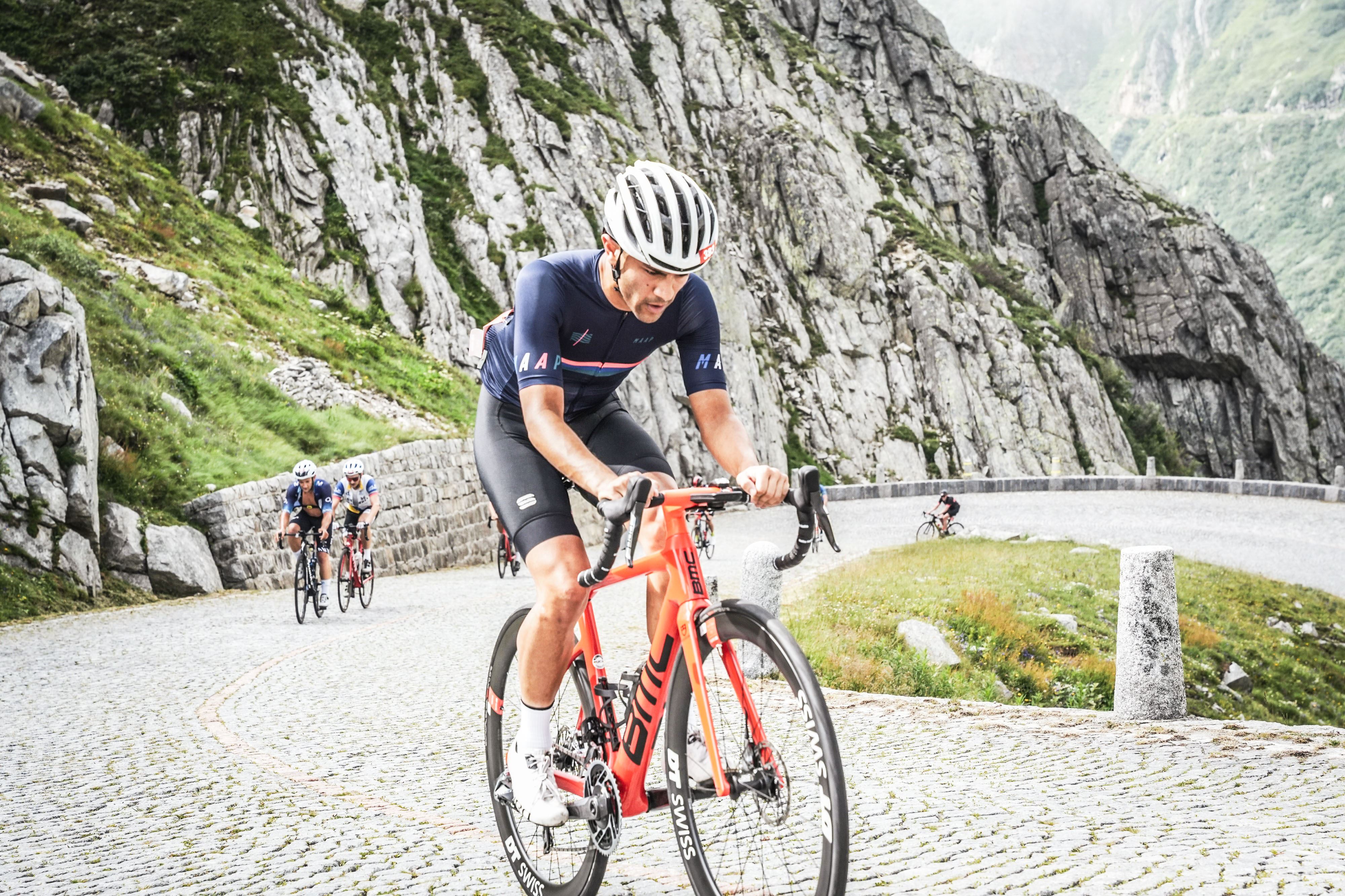
No matter how long and hard I stared down at my Garmin, the numbers weren’t changing. There were 8.8km and 760m of climbing standing between me and the summit of the Nufenen-Pass in the south of Switzerland.
I tried to forget about the 2,400m my legs had already climbed, and as the early afternoon sun beat down on me, I was a certified battered and broken cyclist. I’d pulled into a small gravel lay-by to get a little respite from the unrelenting gradients of the road, while quietly hoping that allowing some of the lactic acid in my legs to dissipate may enable me to finish the job. I pulled out three small packets of gummy sweets and devoured them, not quite the structured fuelling plan I had envisioned they would be a part of but, right there, at that moment, I really needed every bit of help I could get.
Still straddling my bike, after probably 10 minutes of staring at the climb ahead of me, I summoned all the ambition I could muster and pushed off, once again settling into the rhythm of the climb.
One lurking worry that did sit in the back of my mind was my flight home. I would be flying out of Zurich, back to London at 9 p.m., and between where I was now and getting to the airport was a two-hour train journey and the remaining 40km of this ride, a large proportion of which was at an average of 8.6%.
“There’s nothing quite like the risk of being stranded on the continent to keep your legs spinning,” I told myself.
The juxtaposition of battling through my internal monologue to just keeping on climbing and the tranquillity of the mountain was almost cruel. Their quiet, consistent strength was all I could wish to mirror. One question I was suppressing was: why am I here? The answer to which can only be answered by winding the clock back by 10 days.

While I sat in the office on just another Wednesday, Peter Stuart, editor of Cyclingnews, looks up from his computer and asks, ‘Sam, are you free next weekend to go to Switzerland?’. Me, being the young, single and child-free twenty-something-year-old who can cancel plans at the drop of a hat, obviously said yes without hesitation. In the following week, I did a little bit of research into what I was actually letting myself in for.
I’d be taking part in the Granfondo San Gottardo. I somewhat optimistically opted for the 115km route, which consisted of 3,200m of climbing. To put that into a bit of context, that’s around one-third of the height of Everest. Starting in the tiny town of Ambri-Piotta, which consists of not much more than a disused military runway and an ice hockey rink, the route traversed three mountain passes. It started with the partially cobbled Tremola San Gottardo, also known as the Old Gotthard Pass, followed by the Furkapass before finally ascending the Nufenen. Organised by Sette Sports, the same great people behind the ever-popular Chasing Cancellara events and the Zurich-Zermatt event we rode last year, I, along with my fellow riders, were in safe hands.
Before I knew it, a week had passed, and I was frantically packing my bag before heading to the airport. My train journey from Zurich down to Ambri-Piotta gave me just a hint as to what was to come. The vast, almost luminescent blue lakes and towering mountains left my jaw on the floor. As the tracks carved through valleys and, on occasion, right through the middle of a mountain, the feeling of being ever further from civilization dawned. I really was now in the heart of the Swiss Alps, but having got there with relative ease.
I took the opportunity to register on Saturday afternoon, for which I was given a race number to wear, a bike number complete with a timing chip, a food coupon to redeem upon completion of the ride and a helmet sticker. All of this was accompanied by a goody bag from the event sponsors.
The organisers had kindly hooked me up with a bike to complete the ride on, too. I’d be taking on this mammoth challenge aboard a team replica BMC Road Machine. Decked out with a full Sram Red AXS groupset and DT Swiss ARC1400 wheels, this bike was leaving very little to be desired. If I was going to fail this ride, then the bike would not be to blame. However, as mentioned, this is a team replica bike for Tudor Pro Cycling Team. This meant that the gearing was maybe a little harsh for the mountains. With a granny gear of 35/28, I knew at some points I’d be relying on my body weight to turn the pedals rather than by the merit of my legs.

Dawn broke, and the morning sun cut straight through the valley. After sinking multiple bowls of granola in the hotel restaurant, and making a few last-minute adjustments to my bike, I rolled over to the start line. Since the ride was starting on the disused runway, there was plenty of space to spin the legs and get the blood flowing. I had no intention of an early breakaway, in fact, quite the opposite. Out of the 750 or so people taking to the start line, I positioned myself towards the rear of the pack.
Once all were in the starting pen, the countdown came and as 9 a.m. struck, the keen beans kicked off the front. I rolled along with the riders at the rear until people started to stretch out a little, and it was the first few kilometres of the Tremola that really sorted everyone out. I was whizzing past people and ended up somewhere around the middle of the group.
The first handful of hairpins and kilometres were quintessentially alpine. What was new to me, were the cobbles. Small and tightly packed, they weren’t nearly as aggressive as those of the Arenberg forest, but on the first climb of the day when you’re still getting yourself warmed up and in a rhythm, it was a brutal welcome to the mountains, and perhaps, with hindsight, slightly foreshadowed what was to come. The cobbled sections were short at first and there were opportunities to get a break from the constant vibrations with stretches of tarmac, but all too quickly, you were back on the pavé.
The one thought that fuelled me was just how fun it was to be on a closed, alpine climb on real cobbles, overtaking European cyclists. I was living out a peculiar delusion that I was a pro cyclist on the attack, in a race-defining situation. Of course, the reality was very different and my time up the climb will tell you that, but despite how hard the climb was, it was just fun on an epic proportion.

Upon reaching the summit, my legs needed a rest. The sight of the feed station was welcome and as I clambered off my bike. I ate whatever I could get my hands on. The food on offer made it clear that we were not at an event organised in the UK. While the staples of bananas, water, electrolyte drinks, gels and sweets were all present, the salted pretzels, dried apricots, raisins and nuts were a surprise. Take note organisers, these are great options to have. Sweet fatigue is real, having variety in the form of flavour, texture and a balance of sweet and savoury makes tough rides like this much more enjoyable. I grab food by the handful and scoff it down, replenishing myself in preparation for the next climb of the day, but to get there would mean heading back down.
I have never and will never class myself as a descender, which is ironic given how much I love climbing. The next 8km had my adrenaline pumping for a multitude of reasons. While not particularly technical or twisty, it meant the drop down from the Tremola was fast. The black, velvet-like tarmac had riders far more confident than me, bombing down at a rate of knots. Being wary of not wanting to be rescued from a ravine, I gingerly made my way down. The brakes on my BMC took a battering, it was clear that I didn’t need to be breaking as much as I was, as the corners were fast and flowing but throwing caution to the wind is no longer my riding style and since this was my first mountain descent in a while, I wanted to live to tell the tale.
Motorcyclists, drivers and cyclists filled the roads, all getting a healthy shot of endorphins in the bloodstream. As the road meandered down into the valley, the descent spat us all out onto a mountain-lined valley road. The flat, perfectly smooth tarmac was a match made in heaven for my bike, and I couldn’t help but tuck up and make myself as slippery as possible to power myself to the start of the next climb. What awaited had the potential to be the best climb of the day.
The Furkapass followed at 11.6km, 850m of climbing at an average of 7.4%. These stats make the climb the easiest of the day, technically speaking, but it was the landscape which provided the greatest relief.
With the cobbles of the Tremola far behind me, some early twisty switchbacks put me right back into climbing mode. Since the field of riders were now very stretched out, a pecking order had been established, and I was surrounded by riders who were of a similar calibre. As such, I end up sitting behind two riders from Germany. It wasn’t intentional wheelsucking, it was just one of those situations where I wasn’t going fast enough to overtake, but I also wasn’t going quite slow enough to be dropped so, we ended up forming a group of three and we all shared the work of riding on the front. That was until we emerged from the switchbacks and landed on a long, sweeping section of road that was delivering riders to the summit. At this point, being the sucker for a view, I needed to stop and take some pictures.
Reluctantly, I bid farewell to my climbing companions and whipped my phone out. It wasn’t just the gorgeous scenery that took my breath away, but the mountainside was peppered with waterfalls. All with crystal clear bubbling water that looked oh so inviting to a hot, sweaty cyclist.

The Furkapass wasn’t an easy climb, but it was easier. It was highly enjoyable, the fairly consistent gradient really meant you could just settle into it. Paired with a perfect road surface and jaw-dropping views, it may have been my highlight of the day. Again, though, what followed was a descent that matched the climb. After filling my stomach and pockets with food and drink at the feed station, I push forward down the mountain.
The first few switchbacks were quite blustery, but the further I went down, the better it got. The distance between switchbacks became longer, and it was easy to stay tucked up and just push as hard as I could down the road with little worry about anything going wrong. I had finally found a bit of confidence in my abilities, and I’d also gelled with the bike a bit more. Having trust in your equipment is important when riding at 60-plus kilometres an hour. A good understanding of how a bike reacts at speed is important and, I felt, we were much better acquainted now.

This bond between rider and bike was about to be tested to the limit though, because, after navigating a small town and quiet cycle lane, the final test of the day loomed. The Nufenen-Pass had been described to me the day before as by far the hardest climb.
At 12km long, with over 1,200m of climbing at an average of 8.6%, it was the longest, highest and steepest climb. The pit I felt in my stomach as I approached the base of the climb was real.
I had to work hard to remember all the advice I constantly write and talk about at work. Pick an easy gear, rest your hands on the tops of the bars, stay upright and just keep breathing and spinning. The first couple of miles were tough, and I did need to take a couple of pauses to let the burning lactic acid in my legs dissipate. The non-mountain-friendly gear ratio of 35/28 was really starting to bite. What I couldn’t give for just another gear! No matter how long I stopped, as soon as I started again, the burning was back. The sun’s heat was intense, and just trying to keep myself upright was hard work. It’s at this point, you join me right back where this story started.

After pulling out of the gravel lay-by, I told myself I wasn’t going to stop again until I was at the top. This had become a game of mind over matter, and sheer mental discipline would see me through. I barely looked up for the remaining 5 miles, I was laser-focused on achieving my goal of not stopping and not missing my flight home.
The sheer brutality of the climb will never leave me, and I’ll never forget just how deep I had to dig to see myself through what was one of the most challenging things I’ve done on a bike. Perhaps in my younger years when I spent more time riding my bike than doing much else, this would have been far less of a challenge but, as someone who now spends far too much time working with bikes than riding them, I can safely say that this was undeniably tough.
When I did finally reach the top, I couldn’t bare the thought of eating or drinking anything. My stomach was in knots so after forcing myself to sip some water, I just pushed on and towards the finish line. The descent was tough, my broken body was struggling to feel fluid on the roads and in the corners, but when the switchbacks stopped and the roads became more stretched out, I once again tucked up and pushed myself as hard as I could. It’s amazing how even when you think you’ve expended all the energy you have when you’re riding fast, you can always put in an extra dig to go that bit faster.

A group of about seven riders clumped together for the run back into town, so we all rode in a long line, carving through the valley roads and cruising at about 45 kilometres per hour. I could not wipe the smile off my face. The bike was alive, I was so happy to have ridden all three mountain passes, and crucially I now knew I would make my flight back home.
The small town of Ambri-Piotta came back into view and the finish line was in sight, I didn’t want to race any of my fellow finishers to the line, I was just happy to be there. A participation medal was hung around my neck and I quickly made my way to the main tent where food was being served. As I sat there wolfing down some pasta, feeling about 50% human, I started to reflect on what I had just done. While not the longest, at 3,200m, it was the most cumulative elevation I’ve ever done in a single ride, and I was so happy for that.
In total, there were maybe 5 to 10 Brits riding, and, sadly, I didn’t meet any of them, however, the GranFondo Gottardo is an event that anyone from anywhere should do. As a major international hub, getting to Zurich is easy, and it just takes two stereotypically Swiss-run trains to get you to the start line. It’s a perfect long weekend escape. It will challenge you more than anything we have in the UK and all riders were so well looked after. The route, the roads and the mountains are the perfect antidote to those who feel stagnated and need to re-energise their love of all things two-wheeled.
Just don’t expect it to be easy.
For more information on Granfondo San Gottardo visit the official website, and find out more about Chasing Cancellara Zurich – Zermatt here.







